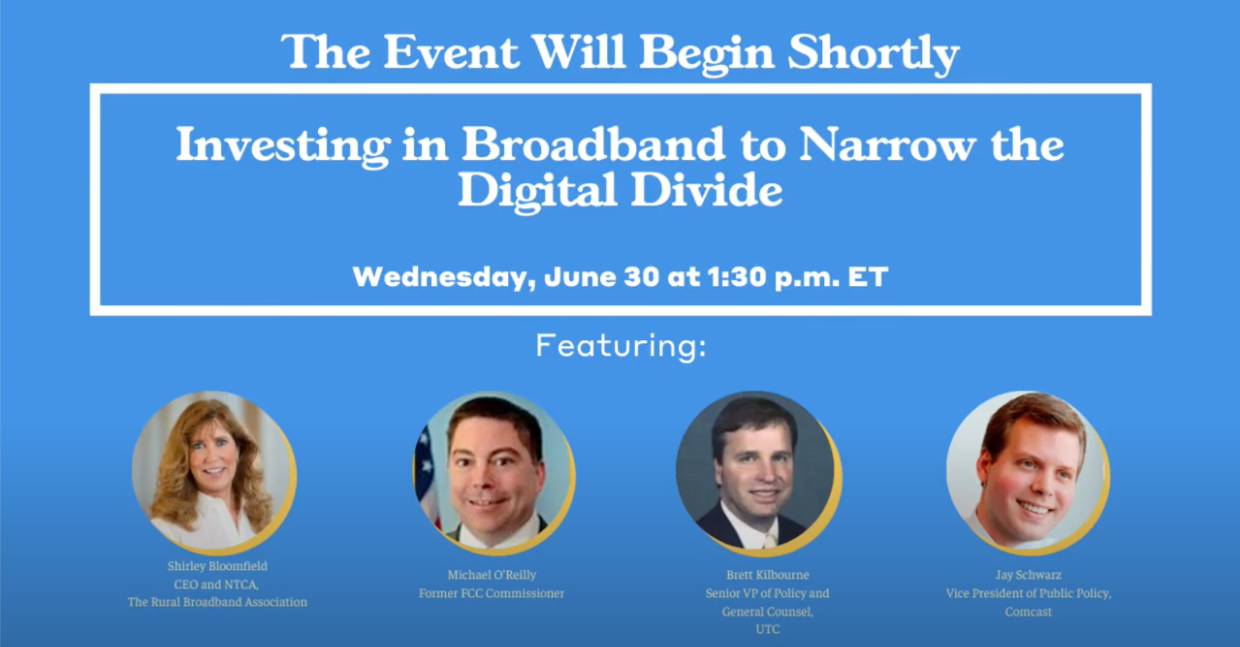
Don’t Waste This Moment to Close the Digital Divide on Bad Policies
By: Katie McAuliffe
Today, the Bipartisan Policy Center hosted a panel entitled “Investing in Broadband to Narrow the Digital Divide.” This panel featured:
- Mike O’Reilly, former Commissioner of the FCC
- Shirley Bloomfield, CEO of NTCA
- Jay Schwarz, VP of Comcast for Public Policy
- Brett Kilbourne, General Counsel for the Utilities technology Council.
It barely needs to be said at this point how pandemic highlighted the essentiality of broadband connectivity. Work, health, school and entertainment all can be extended and enhanced by a connection to broadband. Closing the digital divide is about giving people opportunities The faster we close the digital divide the faster we can give American’s those opportunities.
While the amount of funding isn’t set in stone, it’s certain at this point that the federal government will spend billions of dollars on broadband. All the panelists agreed that this moment cannot be squandered and that we can close the digital divide once and for all.
Commissioner O’Reilly and Mr. Schwarz raised the important point that in this moment, we must keep our focus on actually closing the divide – providing service to those individuals without 25/3 mbps and not get distracted by fanciful policy objectives symmetrical speeds and municipal broadband.
25/3 #broadband has stood the test of time because we are trying to focus on how to connect everyone. Definitions like 100/100 lock out technologies and prevent closing the #DigitalDivide. @MPORielly at @BPC_Bipartisan
— Digital Liberty (@DigitalLiberty) June 30, 2021
Demanding symmetrical speeds has the potential to stall closing the digital divide once again. Changing the definition of broadband changes the definition of unserved. This will lead to the overbuilding of infrastructure in places where there is already acceptable broadband. Ms. Bloomfield of NTCA acknowledged the risk of overbuilding while arguing symmetrical speeds are necessary.
As commissioner O’Reilly and Mr. Schwarz pointed out, consumer behavior does not match any need for symmetrical speeds.
Another bad policy that could continue to waste taxpayer dollars and prevent the closure of the digital divide is municipal broadband. Some panelists argued municipal broadband doesn’t work because it has been restricted by states. That is backwards. Commissioner O’Reilly pointed out that these restrictions came about because of municipal broadband failed too many times.
The municipal broadband network in Chatanooga is often held up as an example of municipal broadband success, but most government owned networks (GONs) end up looking more like the abject failure that is KentuckWired. KentuckyWired is a 3,000-mile GON that was sold to taxpayers as a $350 million project that would be complete by spring of 2016. those projections could not have been more wrong.
More than five years past the supposed completion date, fiber construction for KentuckyWired is still “in progress” in some parts of the state and a report from the state auditor has concluded that taxpayers will end up wasting a whopping $1.5 billion on this redundant “government owned network” over its 30-year life.
KentuckyWired is not the exception. It is the rule. Where GONs have not failed outright, they have required massive additional subsidies from taxpayers and ratepayers. This is because government entities lack the experience and expertise needed to build out and maintain a state-of-the-art broadband network. After the initial construction cost, frequent and expensive technology upgrades remain necessary for a GON to remain current in such an innovative field. This fact is something politicians often forget.
If underestimating the true costs is not problematic enough, government entities also grossly overestimate the demand. Despite having access to a government network, most consumers choose to remain with their trusted private sector provider. Money being used to develop new networks where coverage already exists while people still remain unconnected does nothing to solve the digital divide.
You can watch the panel HERE and check the Digital Liberty Twitter for our live updates
Photo Credit: Bipartisan Policy Center